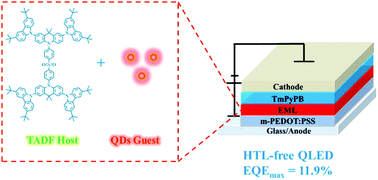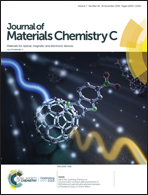Photophysics and electroluminescence of red quantum dots diluted in a thermally activated delayed fluorescence host†
Abstract
A feasible, universal, and low-cost strategy for quantum dot light-emitting devices (QLEDs) was provided to significantly enhance the electroluminescent performances. The emissive layer consists of organic host materials and quantum dots (QDs), and then the efficient energy transfer process remarkably promotes the device performances. It is confirmed that a highly efficient QLED can be realized by a host–guest system without common hole transport layers. The red device based on the thermally activated delayed fluorescence host and QD guest achieved a peak external quantum efficiency of 7.4%. Further, by simply modifying PEDOT:PSS with poly(4-styrenesulfonic acid), the work-function can be easily elevated, accompanied with the boosted external quantum efficiency to 11.9%. It is believed that such performances originate simultaneously from reduced interfacial fluorescence quenching, elevated work-function and efficient Förster resonance energy transfer in the host–guest system.



 Please wait while we load your content...
Please wait while we load your content...